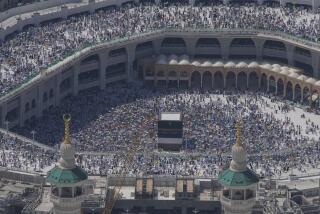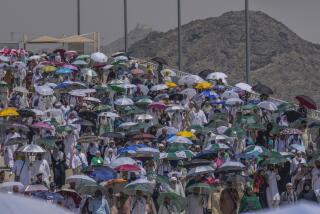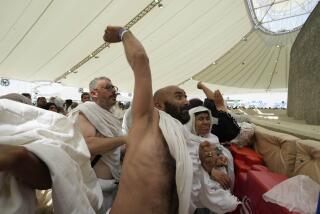For Muslims, this is the trip of a lifetime
- Share via
More than 2 million Muslims from across the globe descended on Saudi Arabia over the weekend to perform the ancient rituals of the hajj, the annual pilgrimage to Mecca that is considered the spiritual pinnacle of a devout Muslim’s life.
As Saudi Arabia’s Ministry of Hajj notes in a website on the event, the word “hajj” merely means “to set out for a place.” But the hajj itself, based on events in the life of the Prophet Abraham, symbolizes essential concepts of Islam, such as submission to God and unity.
The hajj is one of the five “pillars,” or basic requirements, of Islam. The others:
* Belief in one God and in Muhammad as his final messenger;
* Prayer five times a day;
* Zakat, a form of tithing to the needy;
* Fasting during the holy month of Ramadan, if physically able.
This month the Ministry of Hajj announced that it had granted 175,000 visas for foreigners -- among them the Chechen and Sudanese presidents -- to enter the kingdom for the pilgrimage. Thousands of Saudis also will attend the rituals, which began Saturday.
This year controversy has erupted over the participation of Muslims from the Gaza Strip. Thousands of would-be pilgrims have been stranded, unable to travel to Mecca, because of a power struggle between rival Palestinian factions Hamas and Fatah over which has the right to distribute visas to visit Saudi Arabia.
Many hajjis consider the spiritual highlight of the pilgrimage a noon-to-dusk prayer vigil on Mt. Arafat, a granite hill outside Mecca, where the pilgrims pray and ask forgiveness of their sins.
But perhaps the most striking and familiar image associated with the hajj, at least in the non-Muslim world, is the Kaaba, the cube-like building at the center of the marble-paved plaza at the Grand Mosque in Mecca.
All pilgrims in Mecca must complete umrah -- a several-hour series of rituals that start with seven counterclockwise revolutions, or tawaaf, around the Kaaba. Umrah can be performed in conjunction with the hajj or at any time of the year.
Islam teaches that an angel presides over each corner of the building and that the angels will testify on behalf of hajj pilgrims on Judgment Day.
When the Prophet Muhammad, Islam’s founder, was born in 570, the building was already the centerpiece of an ancient annual religious festival observed by various tribes in the Arabian peninsula.
Tradition holds that it was built by the Prophet Abraham (Ibrahim) and his son Ishmael. The Ministry of Hajj describes its construction:
“In order to complete the upper part of the Kaaba, Ibrahim stood upon a large stone block which he moved along when each section was completed. When the Kaaba was finished, the large stone block was left outside, close to the eastern wall of the sanctuary. It became known as the Maqam Ibrahim (station of Ibrahim).
“As constructed by Ibrahim and his son, the Kaaba was a roofless, rectangular building, with two doors set at ground level for access and with a semi-circular back wall.” The Kaaba has been rebuilt and repaired many times over the centuries.
In 630, Muhammad performed the hajj, delivered a venerated sermon on Mt. Arafat and adopted the building as the holiest site in Islam.
Just as Christians incorporated some pagan rituals into their traditions -- think of the Christmas tree -- the ancient hajj rites were modified. Popular religion writer Karen Armstrong, in “Muhammad: A Prophet for Our Time,” describes what happened:
“[Muhammad] led the Muslims through the rituals that were so dear to the hearts of the Arabs, giving them a new significance. Instead of being reunited with their tribal deities, the Muslims were to gather round the ‘house’-- the Kaaba -- built by their ancestors Abraham and Ishmael.”
As Armstrong writes, “Inside the Kaaba, the walls had been decorated with pictures of pagan deities, and Muhammad ordered them all to be obliterated, though, it is said, he allowed frescoes of Jesus and Mary.” (Muslims believe Jesus was one of God’s prophets but do not view him as divine.)
Armstrong goes on to say, “Finally, they sacrificed a sheep, in memory of the sheep Abraham sacrificed after he had offered his own son to God.”
In Islamic tradition, that son is Ishmael; in the Judeo-Christian tradition, it’s Ishmael’s brother Isaac.
To this day Muslims observe Eid al-Adha (Festival of Sacrifice), with the meat of slaughtered animals usually provided to the poor. The three-day festival begins after the conclusion of the hajj, which this year ends today.
Last year, a Times reporter and photographer, Ashraf Khalil and Irfan Khan, respectively, followed a group of Southern Californian Muslims as they traveled to Saudi Arabia to make the hajj.
The series, which chronicled their spiritual journey with stories, photos and graphics, can be found at latimes.com/hajj.
--
More to Read
Sign up for Essential California
The most important California stories and recommendations in your inbox every morning.
You may occasionally receive promotional content from the Los Angeles Times.










